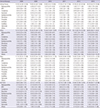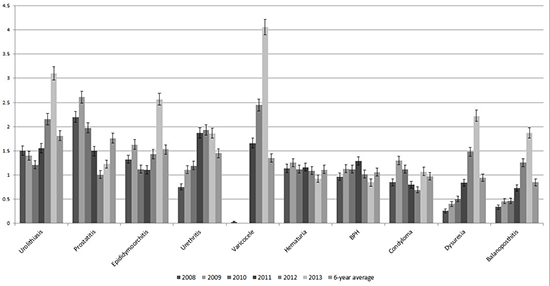1. Miller DC, Saigal CS, Litwin MS. The demographic burden of urologic diseases in America. Urol Clin North Am. 2009; 36:11–27.
2. Finer G, Landau D. Pathogenesis of urinary tract infections with normal female anatomy. Lancet Infect Dis. 2004; 4:631–635.
3. Hussain S, Asghar I, Sabir MU, Chattha MN, Tarar SH, Mushtaq R. Prevalence and pattern of congenital malformations among neonates in the neonatal unit of a teaching hospital. J Pak Med Assoc. 2014; 64:629–634.
4. Siegel R, Ma J, Zou Z, Jemal A. Cancer statistics, 2014. CA Cancer J Clin. 2014; 64:9–29.
5. Bartoletti R, Cai T, Mondaini N, Melone F, Travaglini F, Carini M, Rizzo M. Epidemiology and risk factors in urolithiasis. Urol Int. 2007; 79:Suppl 1. 3–7.
6. Scales CD Jr, Smith AC, Hanley JM, Saigal CS; Urologic Diseases in America Project. Prevalence of kidney stones in the United States. Eur Urol. 2012; 62:160–165.
7. Turney BW, Reynard JM, Noble JG, Keoghane SR. Trends in urological stone disease. BJU Int. 2012; 109:1082–1087.
8. Romero V, Akpinar H, Assimos DG. Kidney stones: a global picture of prevalence, incidence, and associated risk factors. Rev Urol. 2010; 12:e86–96.
9. Williams M, Jezior J. Management of combat-related urological trauma in the modern era. Nat Rev Urol. 2013; 10:504–512.
10. Bagga HS, Fisher PB, Tasian GE, Blaschko SD, McCulloch CE, McAninch JW, Breyer BN. Sports-related genitourinary injuries presenting to United States emergency departments. Urology. 2015; 85:239–244.
11. Bae SR, Seong JM, Kim LY, Paick SH, Kim HG, Lho YS, Park HK. The epidemiology of reno-ureteral stone disease in Koreans: a nationwide population-based study. Urolithiasis. 2014; 42:109–114.
12. Song PH, Kwon ST, Kim HT, Moon KH. The prevalence of urologic disease in young men based on a review of Korean military conscription examination results. Korean J Androl. 2011; 29:218–222.
13. Hoerster KD, Lehavot K, Simpson T, McFall M, Reiber G, Nelson KM. Health and health behavior differences: U.S. military, veteran, and civilian men. Am J Prev Med. 2012; 43:483–489.
14. Ballweg JA, Li L. Comparison of health habits of military personnel with civilian populations. Public Health Rep. 1989; 104:498–509.
15. Barrett DH, Boehmer TK, Boothe VL, Flanders WD, Barrett DH. Health-related quality of life of U.S. military personnel: a population-based study. Mil Med. 2003; 168:941–947.
16. Riddle JR, Smith TC, Smith B, Corbeil TE, Engel CC, Wells TS, Hoge CW, Adkins J, Zamorski M, Blazer D; Millennium Cohort Study Team. Millennium cohort: the 2001-2003 baseline prevalence of mental disorders in the U.S. military. J Clin Epidemiol. 2007; 60:192–201.
17. Stahlman S, Javanbakht M, Cochran S, Hamilton AB, Shoptaw S, Gorbach PM. Self-reported sexually transmitted infections and sexual risk behaviors in the U.S. military: how sex influences risk. Sex Transm Dis. 2014; 41:359–364.
18. Bradley CS, Nygaard IE, Torner JC, Hillis SL, Johnson S, Sadler AG. Overactive bladder and mental health symptoms in recently deployed female veterans. J Urol. 2014; 191:1327–1332.
19. Rhee C, Burkom H, Yoon CG, Stewart M, Elbert Y, Katz A, Tak S. Syndromic surveillance system for Korea-US joint biosurveillance portal: design and lessons learned. Health Secur. 2016; 14:152–160.
20. Szklo M, Nieto FJ. Epidemiology: Beyond the Basics. 2nd ed. Sudbury, MA: Jones and Bartlett Publishers;2007.
21. Hiatt RA, Friedman GD. The frequency of kidney and urinary tract diseases in a defined population. Kidney Int. 1982; 22:63–68.
22. Taylor EN, Stampfer MJ, Curhan GC. Obesity, weight gain, and the risk of kidney stones. JAMA. 2005; 293:455–462.
23. Ku JH, Jeon YS, Kim ME, Lee NK, Park YH. Psychological problems in young men with chronic prostatitis-like symptoms. Scand J Urol Nephrol. 2002; 36:296–301.
24. Collins MM, Stafford RS, O’Leary MP, Barry MJ. How common is prostatitis? A national survey of physician visits. J Urol. 1998; 159:1224–1228.
25. Trojian TH, Lishnak TS, Heiman D. Epididymitis and orchitis: an overview. Am Fam Physician. 2009; 79:583–587.
26. Jeong BD. Clinical observation on 101 cases of epididymitis. Korean J Urol. 1979; 20:191–198.
27. Berger RE, Alexander ER, Harnisch JP, Paulsen CA, Monda GD, Ansell J, Holmes KK. Etiology, manifestations and therapy of acute epididymitis: prospective study of 50 cases. J Urol. 1979; 121:750–754.
28. Majewski S, Rudnicka I. Sexually transmitted diseases in Poland in 2011. Przegl Epidemiol. 2013; 67:283–286.
29. Kayaba H, Tamura H, Kitajima S, Fujiwara Y, Kato T, Kato T. Analysis of shape and retractability of the prepuce in 603 Japanese boys. J Urol. 1996; 156:1813–1815.
30. Kim T, Oh SJ, Choi H. Knowledge and attitude toward circumcision in Korean: a questionnaire study for adult males stratified by age. Korean J Urol. 2002; 43:786–794.
31. Fakjian N, Hunter S, Cole GW, Miller J. An argument for circumcision. Prevention of balanitis in the adult. Arch Dermatol. 1990; 126:1046–1047.
32. American Academy of Pediatrics. report of the task force on circumcision. Pediatrics. 1989; 84:388–391.
33. Kim KH, Park SW. A questionnaire study concerning circumcision of elementary school boys in the city of Gwangju. Korean J Urol. 2008; 49:549–555.
34. Ministry of Health and Welfare (KR). Ministry of Health and Welfare Statistical Yearbook 2014. Cheongju: Ministry of Health and Welfare;2014.
35. Hwang BD. Intention to medical facilities selection according to medical service experience of serviceman. J Korea Contents Assoc. 2010; 10:247–256.











 PDF
PDF ePub
ePub Citation
Citation Print
Print




 XML Download
XML Download